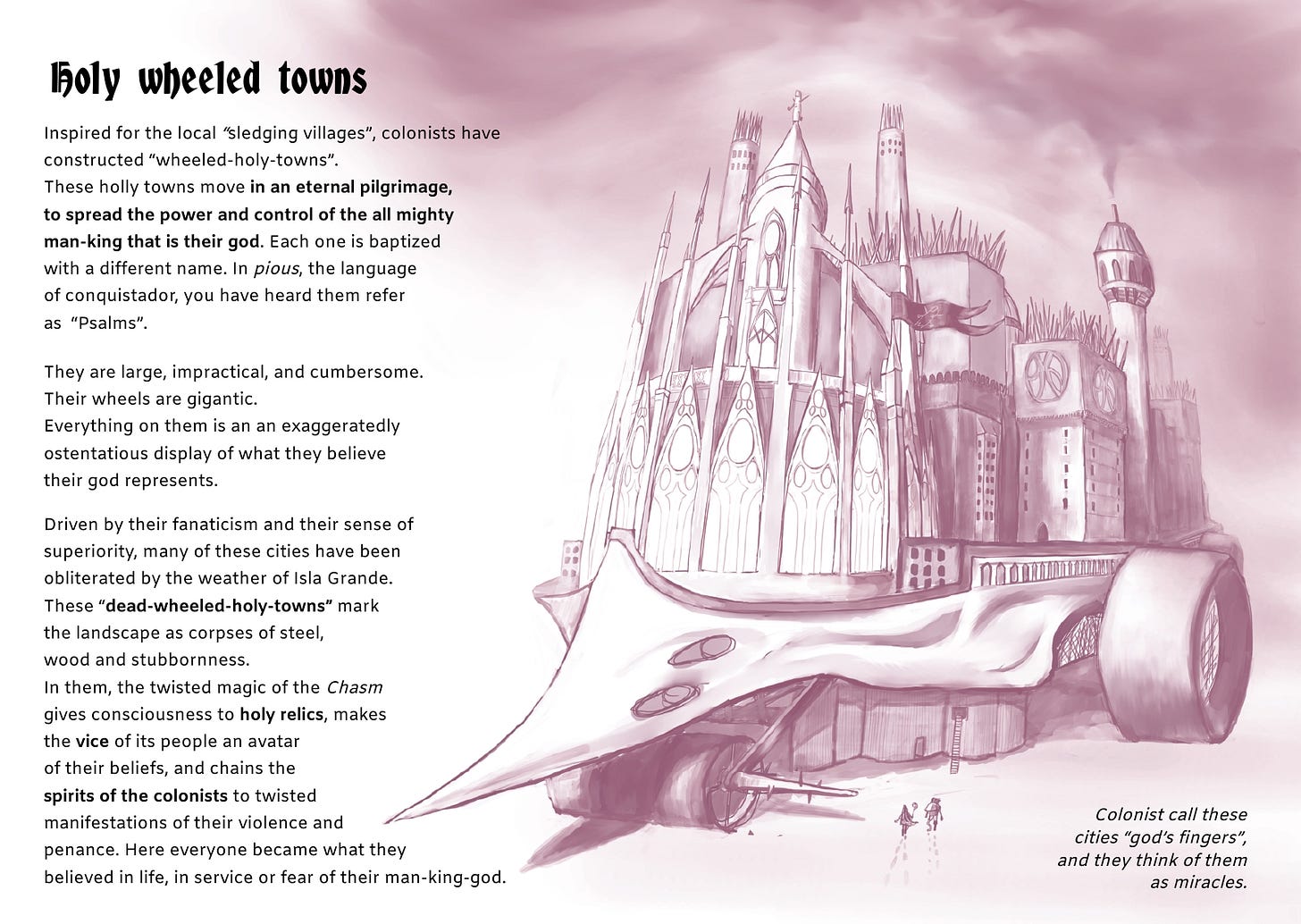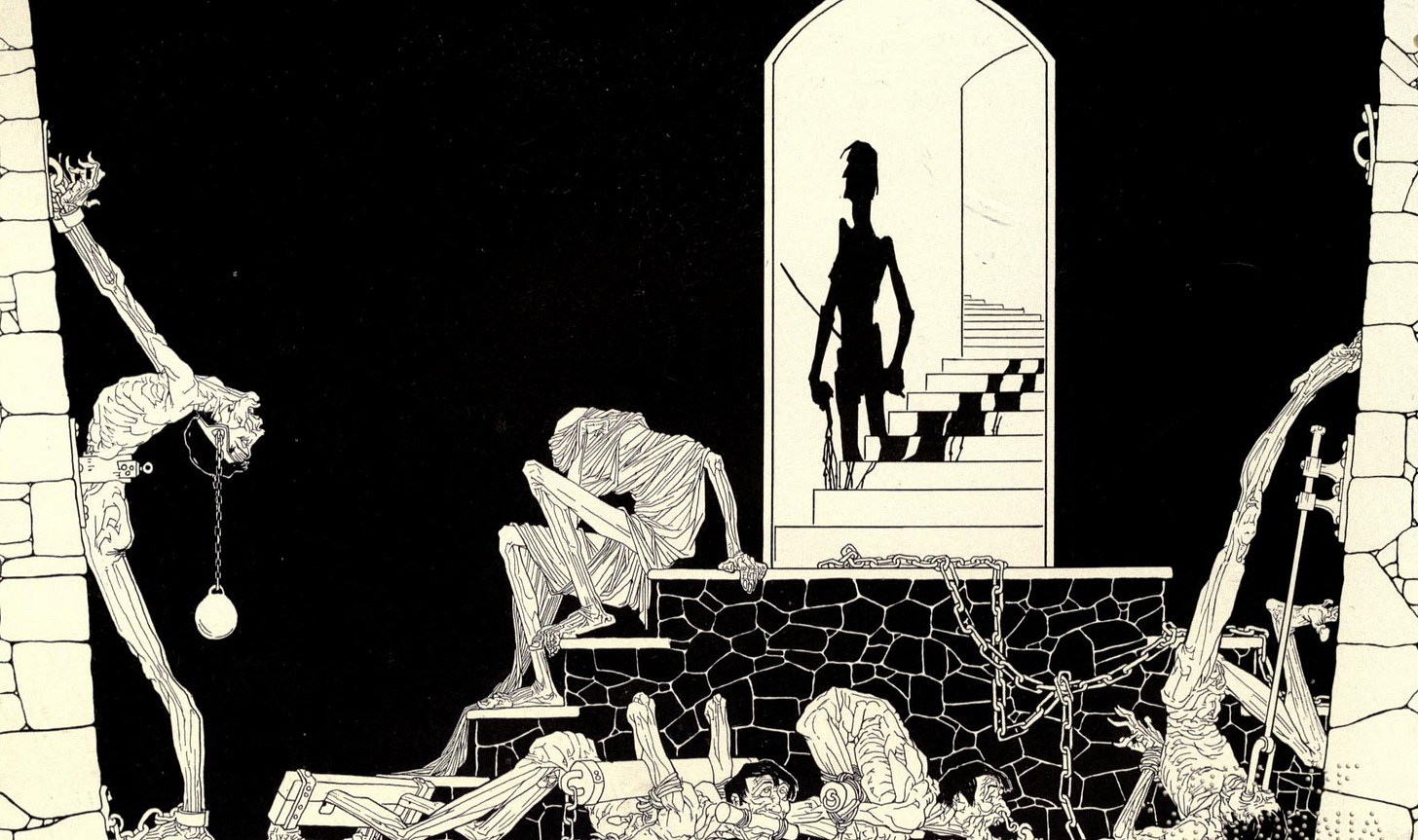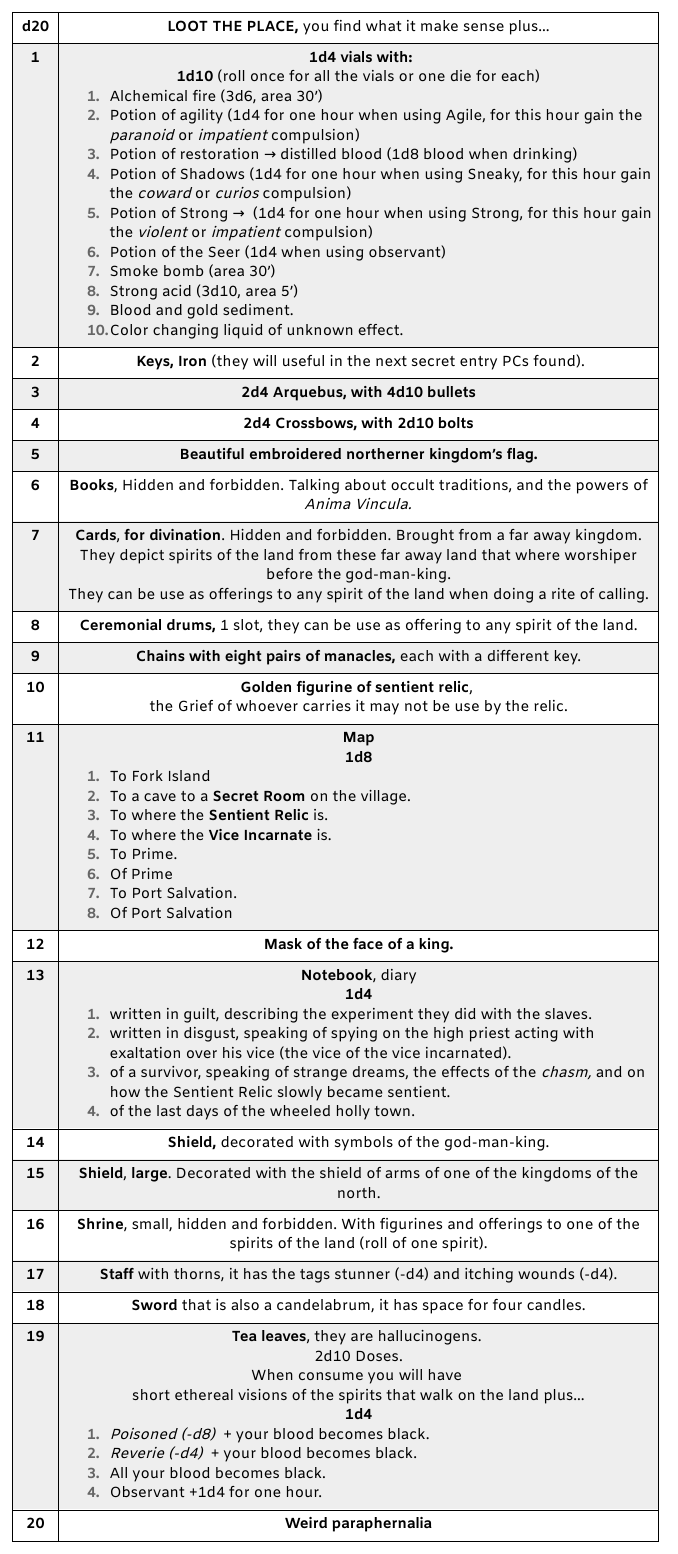Today is the day when will collect many of the previous posts to combine them in the creation of “Dead Wheeled Holy Towns”; the main type of location where adventures will occur in “No Peace for the Heathen” and the place where you should experience in a more condensed form the interaction between the different rules of the game (Combat, Grief, Dominance, Level Up, Blood Tint,).
Similar to all previous posts, if you want to use a “Dead Wheeled Holy Towns” in your game, at the end of the post I will leave an easy conversion for games like OSE and Mork Borg.
The steps we will take to build this town
Roll for the most general aspects of the town: Name, Streets, Particularity, Landmark, and Dark Secret.
Drawing a pointcrawl for representing the town, with 4, 6, or 8 nodes, with all the connections between them defined by a simple random method.
Define the type of connections between nodes: Screte Passage, Collapsed Path, Dangerous Paths, Corridor, or Street.
Define what type of location each node is. There are tables for all this and more!
Set what kind of “Colonist Spirits” live inside the town.
Find out what “Sentient relic” awakened on town.
Build the “Vice Incarnated” born from the vices of the dead priest.
Finally, define clues to spread throughout all the locations. These clues will give PCs information about all the things that are at play in the town, like other explorers, secrets, hidden locations, the creatures that roam the town, the destiny of its inhabitants, etc…
The general aspects of the town
First, let’s roll in the next table to define the more general aspects of the dead town, once for each column.
Drawing the pointcrawl
“Dead wheeled holy towns” are represented by point-crawls, where nodes are interesting locations and links between nodes are the pathways that connect these locations.
There are three sizes for them, depending on the time you want to invest in playing/exploring them. The size determines how many important locations the town has and how many connections between locations could exist.
The point crawl does not correspond to the actual physical size as experienced by the players characters (PCs). This is only a map of the important locations within the town, and there can be many other places inside it —like homes, squares, small shrines, etc… — that will not be defined/specified on the pointcrawl map but whose aesthetic and vibe will be guided by what you rolled on the previous table.
The pointcrawl's sizes, by number of nodes, are 4, 6, or 8.
The procedure for creating the pointcrawl representing the “Dead holy wheeled town” is virtually the same for all sizes.
So, let’s draw a simple pointcrawl!
Procedure to create pointcrawl with 4/6/8 nodes:
First, draw the 4/6/8 nodes, leaving three in the center to differentiate them from the rest (you can also draw them with a different shape). These are nodes 1, 2 and 3.
Numarate all the nodes.
Roll 2d6/2d8/2d10; the results determine the number of connections between locations (nodes).
For each connection roll 2d4/2d6/2d8 → the number of each dice is the number of the locations (nodes) that are connected.
If it is connected to itself, it has another interesting floor, level.
If a connection is repeated, ignore it.
Draw all the connections.
If a place is not connected to any other place roll a d4/d6/d8. The result is the number of the node to which this location is connected. This connection is a secret passage. If a location ends up connected to itself, make evident why it is disconnected from the rest of the locations (surrendered by fire, magically floating on mid-air, in the middle of a pool of acid, etc…)
Now that we have the pointcrawl, let’s define what are each node, and of what type are the connections between them.
Defining each connection and node.
Locations 1, 2, and 3 are where the “Sentient Relic”, the “Vice Incarnated” , and the “Dark Secret” are hidden/waiting (we will roll for the “Sentient Relic” and the “Vice Incarnated” in the next step).
Only if it is specified in their description then the “Sentient Relic” or “Vice Incarnated” move through the town.
If there is at least one street, then PC can enter through it to the town (ladders, stairs, ropes, lifts, or any kind of access reaches at least one of the streets). If there are no streets, roll 1d8, this is the nod through which you can enter the town.
For each CONECTION roll 1d6 and write parallel to the connection what it is (you should use different kind of lines for each kind of connection):
1: Secret passage → – – – – - - -
2: Collapsed path → / – / – / – / -
3: Dangerous path → - x – x – x –
4: Corridor → ==========
5- 6: Street → —————
Defining what is each node
For each LOCATION roll 1d20 in the “Dead holly wheeled town” location table that is bellow.
With the location table, you will define what the location is and its state. If the location has more than one interesting floor, roll two times for satate, one for each floor.
Whenever the location is Ocupy, Overtaken, or has a Secret Room, use the other tables accompanying the location table.
If PCs encounter Islanders, dead or alive, you can roll for them HERE.
If PCs encounter Conquistadors, Inquisitors, or Colonists, dead or alive, you can roll for them HERE
Rolling for the creatures hidden in town
Roll for one or two types of “colonist spirits” that are trapped on town (1d12)...
Feral rapture of the cannibal sin.Blind follower's choir.Chained slaves of pain.Flaming penitents.Death followers of the flesh and blood.Human weaves of communion and despair.Slugs of the lustful rapture.Mechanical lives of eternal servitude.Pallbearers of the sinners’ dreams.Plague bearers.Ink-covered scribes.Shadows of greed.
...and find them HERE.
Roll for the holy object that became a “sentient relic” due to the presence of the Chasm (1d12):
Thorny hammer of the Silent Mother.
Bell of the First Word.
Gallows of the first Sinner.
Helm of the Warrior Priest.
Flaming heart of the penitent mother.
First Tree of Fervour.
Undying holiness of eternal repentance.
Leviathan of Holy Scribes.
Mirror of the First Vision.
Brothers of the Sin and the Pain incarnated.
The stag head of the blind queen.
Sphere of the illusions of the sinners’ life.
...and find it HERE.
And finally, USE THIS to build the “Vice Incarnated” into whom the priest of town transformed under the effect of the Chasm.
Adding clues to locations
Clues are pieces of evidence that give information about other locations, paths, characters, creatures, or anything related to any of the quests of the PCs.
For PCs, while navigating the town, the most important are the clues of paths and locations, because these will reveal to them how and where they can move next.
The things to which clues point in a Dead Wheeled Holy Town are:
Colonist spirits (CS)
Vice incarnated (VC)
Dark secret (DS)
Sentient Relic (SR)
Secret passages (SP)
Secret exits/entrances (SE/E)
Secret rooms (SRoom)
NPC alive in the villagers (NPC)
Any extra knowledge/information related to any quest pursued by the PCs that you wish to incorporate in the town (Ex)
For every of these “bits” of information, there are 3 clues that you will have to create (wait until you know where the clues are to create them).
Roll for every clue of each “bit” a dice corresponding to the size of the village (d4/d6/d8), the result is where the clue is.
Then add each clue to the pointcrawl beside the location that corresponds, using the abbreviation of the “bit” they belong/point to.
Example1: Clue1 of Vice Incarnated is at Location 3, so beside location 3 write VC1.
Example 2: Clue2 of Dark Secret is at Location 6, so beside location 6 write DS2.
Then write for each “bit” the three clues, using the location and the nature of the “bit” as a source of inspiration to what the clue could be.
Example1: The clue VC1 (first clue of Vice Incarnated) is in location 3. This location is a manor and the VC is Anger. So the clue is: → a trembling bloody man with a knife surrounded by corpses repeating “They were laughing at me”, he says when anyone enters the room.
Example2: The clue DS2 (second clue of Dark Secret ) it is in location 6. This location is a church and the DC is “Inquisitors. Where experimenting with magic and holiness”. So the clue could be: → remains of vessels and copper machinery hidden below the sits of the church.
Try to create clues that players can find without having to roll to find them; do not hide clues behind the rolls.1
Now what?
You now have a “Dead holy wheeled town” to use in your games, and, as I told you before, at the end of this post, there is a simple conversion to use this adventuring location with OSR/NSR games like OSE and Mork Borg.
But even if we already have a lot going on in this dead town, there is a crucial ingredient missing to make the exploration of it more interesting: EVENTS! So, in the next section, you will find some events that you can use when PCs are exploring this town.
Also, if PCs want to LOOT a place or a corpse —they always want— below there are some tables that may help you with this.
What happens when PCs are in town?
When PCs move between nodes
When PC TRANSVERSE a connection make them roll 1d20 against their Grief (analogue to XP/Tresure/Omens, see below in conversion). If any of them gets a number belowe their Grief, then there is an event and you must roll in the “Dead holy wheeled town” event table that is below.
If someone gets a Chasm’s scar you can find it HERE.
If PCs encounter Islanders you can roll for them HERE.
If PCs encounter Conquistadors, Inquisitors, or someone who lived/lives in the holy-wheeled town (Colonist), you can roll for them HERE
When PCs are resting
When PC REST make them roll 1d20 against their Grief (analogue to XP/Tresure/Omens, see below in conversion). If more than half of them gets a number belowe their Grief, then there is an event and you must roll in the “Dead holy wheeled town” event-when-resting table that is below.
If someone gets a Chasm’s scar, you can find one HERE.
For when PCs want to loot the place or the body
If they get a “Weird Paraphernalia” you can roll for one HERE.
Conversion to OSE and Mork Borg and notes
…for something like OSE you can use this:
Grief → XP or Treassure carried by PCs or sum of both (divided by 1000).
Tactic to Stat/Attribute:
Strong → STR,
Agile → DEX
Imposing → CHA
Resilient → CON
Sneaky → DEX
Observant → WIS
Blood → HP
…for something like MÖRK BORG you can use this:
Grief → Omens, or Silver dived by 100, or the sum of both.
Tactic to Stat/Attribute:
Strong → Strenght
Agile → Agility
Imposing → Presence
Resilient → Toughness
Sneaky → Agility
Observant → Presence
…for both you could also add this:
Let the PCs spend “X” HP to increase their roll by “X”.
If anything has just one stat, it can use it for everything.
Conditions modify the rolls of anything that make sense (spring ankle will hinder jumping, confused will hinder perceptions, anger will hinder interactions, etc…). Conditions stack.
I took the idea/concept of the three clues from this amazing post, by Justin Alezander. I totally recommend to have a read to all his amazing tips.











